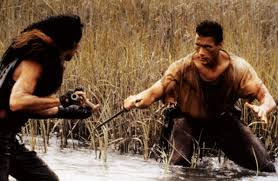Cyborg (1989)

Cyborg is a 1989 science fiction action film that has garnered a cult following over the years, primarily due to its unique blend of martial arts and dystopian themes. Directed by Albert Pyun, the film showcases the early talent of Jean-Claude Van Damme, who plays the lead role of Gibson Rickenbacker. Set in a post-apocalyptic world ravaged by a deadly plague, the film explores themes of survival, humanity, and the moral implications of technology.
The narrative follows Gibson, a former soldier who has become a mercenary in a desolate future. The world has been devastated by a virus that has decimated the population, and civilization has crumbled into chaos. Amid this bleak landscape, Gibson is hired to protect a cyborg named Pearl Prophet, played by Dayle Haddon. Pearl is not just any cyborg; she possesses advanced technology that may hold the key to developing a cure for the plague. Her existence represents hope for humanity’s future, making her a target for ruthless marauders led by the sinister Fender Tremolo, portrayed by Vincent Klyn.

As Gibson and Pearl embark on their perilous journey to safety, they are pursued relentlessly by Tremolo and his gang of mercenaries. The film’s action sequences are a highlight, featuring intense martial arts fights that capitalize on Van Damme’s physical prowess. Each confrontation is choreographed with a blend of brutality and finesse, showcasing the protagonist’s skills as he battles for survival. The film’s pacing keeps viewers engaged, alternating between moments of high-octane action and quieter, introspective scenes that delve into the characters’ motivations and struggles.

Visually, Cyborg captures the desolation of its setting through gritty cinematography and a muted color palette, which enhances the film’s post-apocalyptic atmosphere. The production design effectively conveys a world in decay, filled with remnants of a once-thriving civilization. This aesthetic choice immerses viewers in the film’s bleak reality, allowing them to feel the weight of the characters’ challenges. The use of practical effects and set pieces contributes to the film’s authenticity, even if the budget constraints are apparent in some sequences.

The film also explores deeper themes, particularly the ethical considerations surrounding technology and its impact on humanity. Pearl’s character embodies the intersection of human and machine, prompting questions about identity and the nature of existence. As Gibson protects her, he grapples with his own sense of purpose and redemption, reflecting on his past and the choices that have led him to this point. This character development adds a layer of complexity to the narrative, elevating it beyond a straightforward action film.

Despite receiving mixed reviews upon its initial release, Cyborg has since gained recognition as a cult classic within the action and science fiction genres. Critics often pointed out its ambitious premise and the limitations imposed by its budget, but audiences have come to appreciate its unique charm and the blend of genres it offers. The film stands out for its early depiction of cybernetic themes in cinema, paving the way for future explorations of similar concepts.
In conclusion, Cyborg is a distinctive film that combines the action-packed elements of martial arts with a thought-provoking narrative about survival and technology. Jean-Claude Van Damme’s performance as Gibson Rickenbacker anchors the film, while the supporting cast, including Vincent Klyn as the antagonist, adds depth to the story. The film’s exploration of humanity’s struggle against a backdrop of chaos and decay resonates with viewers, making it a noteworthy entry in the landscape of late 80s cinema. As a piece of genre filmmaking, it captures the spirit of its time while offering themes that remain relevant today. The enduring appeal of Cyborg lies in its unique blend of action, science fiction, and philosophical inquiry, solidifying its place in the pantheon of cult classics.











